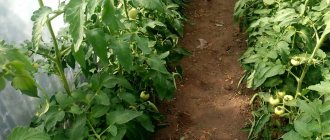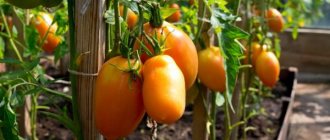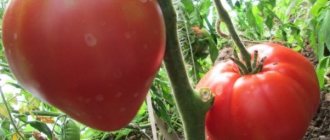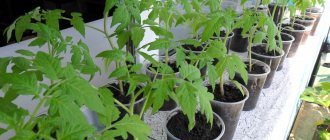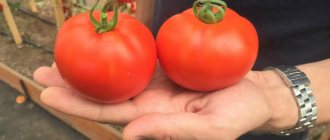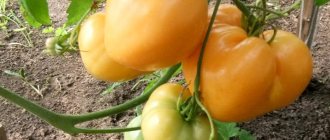History of the appearance of the variety
This tomato variety was bred in the last quarter of the last century by breeders from the experimental breeding station of Krymsk (Krasnodar Territory) - a branch of the North Caucasus Research Institute of Viticulture and Horticulture.
This tomato was included in the State Register of the country back in 1986 and recommended for growing in garden beds in the North Caucasus District and other Russian regions with similar climatic conditions.
Tomato Titan
It is better not to plant this variety in greenhouses and film greenhouses, as it is not intended for this. And since the tomato is late-ripening, it is not grown in open ground in regions with colder climates, because the crop simply will not ripen in the short summer period.
Related article:
The best varieties of yellow tomatoes
Transplanting seedlings into open ground
For the southern regions of Russia, this time falls in May ; the central part carries out transplantation in early summer . If it is intended to be grown in greenhouse conditions, everyone can transfer seedlings into May .
If the soil is sufficiently fertilized and regular fertilizing is carried out, seedlings can be planted according to the scheme of nine bushes per square meter . Before transplanting, the soil is spilled with a solution of copper sulfate, and mineral fertilizers are applied to each hole.
Before planting Titan seedlings in the ground, the soil is spilled with copper sulfate
Description of the variety
This tomato variety belongs to the standard determinant type, with an average shoot height of no more than 0.5 m. The development of the bushes ends with the formation of a flower cluster at the top of the shoot.
The bushes are compact, powerful, the central stem is thick and erect. The plant produces an average number of lateral shoots, and the foliage is average. Therefore, vegetable growers will not have to remove the stepsons.
The foliage is large, elongated, wrinkled, shiny, dark emerald in color.
Tomato Titan reviews and description of the variety
The first inflorescence of this tomato is usually formed under the 6th leaf, and each subsequent inflorescence is formed through 2 true leaves.
The variety is late-ripening - from the moment of seed germination to the harvesting of ripe tomatoes, 4 - 4.5 months pass.
Ripe fruits are round and flat-round in shape, weighing 90-140 g. The skin is green during ripening, fully ripe tomatoes are rich red in color. The skin is dense, smooth, shiny, and not prone to cracking. The pulp is fleshy, with a large number of seed chambers and an average number of seeds.
Related article:
Prohibition" for tomatoes (Kazarin method)
The taste of ripe tomatoes is typical of a tomato, sweetish with a characteristic sourness.
Tomato Titan photo
The harvested crop can be transported to different distances, and also stored in appropriate conditions for quite a long time.
Main characteristics
The variety is late-ripening, so it is better to grow it in the southern regions, where the crop has time to ripen in garden beds.
Productivity
For a tomato variety bred in the last century, the yield of the Titan tomato is quite high - about 4 kg of ripe tomatoes are harvested from each bush. No more than 6 plants are planted on each square of area; accordingly, the yield per 1 m2 can be up to 24-27 kg of ripe produce.
Tomato Titan red
Area of application of fruits
Thanks to their pleasant taste, ripe Titan tomatoes are good for preparing vegetable salads and other snacks. They are also used for preservation, because their skin does not burst during heat treatment, for making sauces, tomato paste or lecho.
Related article:
Tricks for caring for tomatoes
Diseases and pests
Due to the late period of fruit ripening, this tomato is characterized by low resistance to late blight, is quite resistant to macrosporiosis and septoria, and can be affected by stolbur.
Brown spot of tomatoes
Among the pests, Titan tomato bushes can be attacked by aphids and spider mites. You can fight these harmful insects with folk remedies, treating tomato bushes with an infusion of red pepper or tobacco, or using a soap solution. When a colony of insects grows greatly, the pests can only be controlled with the help of insecticidal preparations.
How to grow tomatoes
Before planting seedlings in the garden, prepare the beds and soil. In the fall, the soil is carefully dug up, all debris and weeds are removed from the soil, and manure is added. With the arrival of spring, the soil is dug up again so that it becomes loose and nutritious.
Landing
During planting, it is important not to damage the fragile and still weak roots of the plants, so they are replanted as carefully as possible. The distance between the bushes should be 40-50 cm.
For planting, select the sunniest and most spacious place in the garden, away from groundwater. The best predecessors for tomatoes are cereals and legumes. It is not recommended to plant Titan after other tomatoes or potatoes.
Care
Caring for tomatoes consists of standard procedures. The variety does not require the formation and garter of a bush, which distinguishes it from other tomatoes.
To get a rich and tasty harvest, you need:
- Water the beds once every 5-7 days. One bush consumes 1.5-2 liters of water. The frequency and amount of watering depends on weather conditions. If the summer is hot and humid, the procedure is performed less frequently.
- Regularly loosen the soil before watering. Loosening improves oxygen access to the roots and makes the soil more airy.
- Remove weeds that take away vitamins and nutrients from tomatoes.
- Apply organic and mineral fertilizers. Tomato Titan reacts well to urea, liquid mullein, ash, nettle, and ammonium nitrate. Fertilizing not only strengthens the immunity of the bushes, but also improves the taste of the fruit.
Features of cultivation and possible difficulties
Before planting, experienced farmers recommend liming the soil. This reduces the acidity of the soil, fills it with nutrients and useful microelements. To do this, gardeners use lime or dry wood ash. For 1 sq. m. consume 5 liters of substance.
To make tomatoes grow tasty, foliar feeding is carried out. They protect vegetables from pests and diseases. As foliar feeding, spraying with a solution of nettle, ash or Bordeaux mixture is used. 1 bush requires 1.5 liters of solution.
Diseases and pests
Late blight is recognized as the most common disease . This is a fungal disease that appears as brown, brown and yellow spots on leaves and fruits. Infection occurs through seeds, soil, and garden tools.
The disease actively develops in conditions of high humidity and heat. For prevention purposes, use manganese or copper sulfate. If the bushes are already sick, it is better to remove the infected specimens and burn them away from the beds.
In addition to late blight, root rot attacks the beds. The disease affects the roots of the bushes, which soon causes the entire plant to die. Liming and ash are used against rot. Another disease is called powdery mildew. Dew looks like a white coating on the leaves. It is recommended to fight it with a soap solution.
The most common insect pests found on tomatoes are the Colorado potato beetle, mole cricket, aphid or whitefly.
Insects suck nutritious juices from the plant, destroy roots and fruits.
For prevention and control, professional preparations “Tornado”, “Oxychom”, “Maxim” are used.
Landing
Tomato seedlings
It is recommended even in the southern regions to grow this variety in seedlings. At the same time, the deadline for collecting ripe products will shift.
Seed material should be planted for seedlings approximately a couple of months before transplanting to a permanent place in the beds.
As the seedlings grow, it is necessary to regularly water them with warm, settled water, avoiding getting it on the leaves and stems. After several permanent leaves appear, the thickened plants should be picked into separate containers.
During growth, seedlings are fed twice - a couple of weeks after picking and 12-14 days before transplanting to garden beds. Fertilizers containing large amounts of nitrogen are used as top dressing. 12-14 days before transplanting, Titan tomato seedlings should begin to be hardened. To do this, the plants are moved outside or onto an unglazed balcony for a short time at first. But gradually the plants need to be left in the fresh air all day, and then at night.
Related article:
Tomato Apricot f1 - description and characteristics of a large-fruited variety
Planting tomatoes
You need to transplant the seedlings to a permanent place in mid-May, planting the seedlings in rows. In this case, the distance between the bushes in a row should be about 0.5 m, and the width between the rows should be 0.4 m. And it is fashionable to plant up to 6 tomatoes of this variety per square area.
Further care
Further care for bushes of this variety includes compliance with the watering regime, fertilizing, periodic preventive spraying of plants against major diseases, as well as loosening and weeding.
The bushes should be watered 2-3 times a week as the top layer of soil dries. Watering is carried out in the morning or evening with settled water.
After watering or rain, you need to loosen the soil to break up the dry crust that appears. At the same time, you need to remove all weeds along with the roots.
During the period of bush growth and active fruit ripening, fertilizing should be done at intervals of 1.5 weeks. In spring, fertilizers with a high nitrogen content are used. And from the moment of budding, superphosphate and potassium salts are added under the bushes of this tomato.
Related article:
How to speed up the ripening of tomatoes
Growing Tips
The trunk of the plant needs to be staked as needed. The branches are literally strewn with fruits and are under heavy loads; they need supports. The bush is formed into two or three stems, but more often into three. During development and active growth, it needs fertilizing containing potassium and phosphorus.
You can learn more about the most common tomato diseases in greenhouses here. We will also tell you about ways to deal with them. On our website you will find reliable information about such scourges as Alternaria, Fusarium, Verticillium, late blight and methods of protection against late blight.


